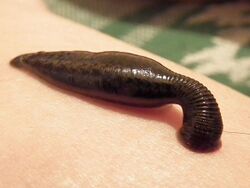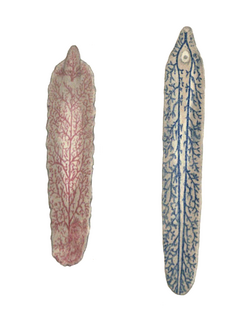Biology:Acetabulum (morphology)
Acetabulum /æsɪˈtæbjʊləm/ (plural acetabula) in invertebrate zoology is a saucer-shaped organ of attachment in some annelid worms (like leech) and flatworms. It is a specialised sucker for parasitic adaptation in trematodes by which the worms are able to attach on the host.[1] In annelids, it is basically a locomotory organ for attaching to a substratum. The name also applies to the suction appendage on the arms of cephalopod molluscs such as squid, octopus, cuttlefish, Nautilus, etc.[2][3]
Etymology
Acetabulum literally means "a small saucer for vinegar". It is derived from two Latin words acetum, meaning "vinegar", and -bulum, a suffix denoting "saucer" or "vessel" or "bowl". The name is used because of the saucer-like structure in the invertebrates.[2]
Structure
Annelids
In leeches, acetabulum refers to the prominent posterior sucker at the extreme end of the body. In fact it forms a head-like structure, while the actual head is relatively small. It is a thick disc-shaped muscular system composed of circular, longitudinal and radial fibers.[4]
Trematode
In flatworms, acetabulum is the ventral sucker situated towards the anterior part of the body, but behind the anterior oral sucker. It is composed of numerous spines for penetrating and gripping the host tissue. The location and structure of the acetabulum, and the pattern of the spine alignment are important diagnostic tool among trematode species.[5][6]
Mollusc
Acetabulum in molluscs is a circular hollow opening on the arms. It occupies the central portion of the sucker and surrounded by a larger spherical cavity infundibulum. Both these structures are thick muscles, and the acetabulum is specifically composed of radial muscles. They are covered with chitinous cuticle to make a protective surface.[7][8]
Function
Acetabulum is essentially an organ of attachment. In annelids, it is used for adherence to the substratum during a looping locomotion. Annelid worms such as leeches move by repeated alternating extensions and shortenings of the body. This in turn is done by successive attachment and detachment of the oral sucker and the acetabulum.[9] In flukes it is used for penetrating the mucosal wall of the gastrointestinal tract for maintaining its parasitic habitat. It is sensory in nature consisting of type 2 sensory receptor, which is a smooth bulb-like non-ciliated papilla.[10]
Mollusc
Molluscans uses it for grasping substratum, catching prey and for locomotory accessory. The best studied acetabular activity is that of octopus. Octopus arms contains 200-300 independently controlled suckers that can grasp small objects and produce high adhesion forces on virtually any non-porous surface. This precise mechanism of high flexibility even has a potential mechanical applications in robotics.[11][12] Each sucker is a tactile sensor for detecting the surrounding. When the sucker attaches itself on an object, the infundibulum mainly provides adhesion while the central acetabulum is quite free. This provides greater suction on the flat surface; hence, making pressure incredibly low. This is why octopus grip is exceptionally firm. Then contraction of the radial muscle of the acetabulum causes detachment of the entire sucker.[7][13]
References
- ↑ Castro GA (1996). "Helminths: Structure, Classification, Growth, and Development". in Baron S. Medical Microbiology (4 ed.). Galveston (TX): University of Texas Medical Branch at Galveston. ISBN 978-0-9631172-1-2. https://www.ncbi.nlm.nih.gov/books/NBK8282/.
- ↑ 2.0 2.1 Collins Dictionary. "acetabulum". collinsdictionary.com. Collins. http://www.collinsdictionary.com/dictionary/english/acetabulum.
- ↑ "Adhesive mechanisms in cephalopods: a review". Biofouling 22 (5–6): 329–338. 2005. doi:10.1080/08927010600967840. PMID 17110356.
- ↑ "Morphological and ultrastructural aspects of Branchiobdella pentodonta Whit. (Annelida, Oligochaeta) suckers". J Morphol 170 (2): 195–205. 1981. doi:10.1002/jmor.1051700206. PMID 7299828.
- ↑ "Morphological features of the nasal blood fluke Trichobilharzia regenti (Schistosomatidae, Digenea) from naturally infected hosts". Parasitol Res 110 (5): 1881–92. 2012. doi:10.1007/s00436-011-2713-9. PMID 22146993.
- ↑ "A review of the Apocreadiidae Skrjabin, 1942 (Trematoda: Digenea) and description of Australian species". Syst Parasitol 44 (1): 1–36. 1999. doi:10.1023/a:1006197201426. PMID 10619071.
- ↑ 7.0 7.1 "The structure and adhesive mechanism of octopus suckers". Integr Comp Biol 42 (6): 1146–1153. 2002. doi:10.1093/icb/42.6.1146. PMID 21680399.
- ↑ Walla G (2007). "A study of the Comparative Morphology of Cephalopod Armature". tonmo.com. Deep Intuition, LLC. http://www.tonmo.com/science/public/gcwalla.php.
- ↑ "A kinematic study of crawling behavior in the leech, Hirudo medicinalis". J Comp Physiol A 158 (4): 593–603. 1986. doi:10.1007/bf00603803. PMID 3723440.
- ↑ "Topography and ultrastructure of the tegument of Deropristis inflata Molin, 1859 (Digenea: Deropristidae), a parasite of the European eel Anguilla anguilla (Osteichthyes: Anguillidae)". Parasitol Res 112 (2): 517–528. 2013. doi:10.1007/s00436-012-3162-9. PMID 23052788.
- ↑ "Inspiration, simulation and design for smart robot manipulators from the sucker actuation mechanism of cephalopods". Bioinspir Biomim 2 (4): S170–81. 2007. doi:10.1088/1748-3182/2/4/s06. PMID 18037726. Bibcode: 2007BiBi....2..170G.
- ↑ "Design of a biomimetic robotic octopus arm". Bioinspir Biomim 4 (1): 015006. 2009. doi:10.1088/1748-3182/4/1/015006. PMID 19258690. Bibcode: 2009BiBi....4a5006L.
- ↑ Octopuses & Relatives. "Learn about octopuses & relatives: locomotion". asnailsodyssey.com. http://www.asnailsodyssey.com/LEARNABOUT/OCTOPUS/octoLoco.php.
External links
- Definition at Merriam-Webster
- Definition at The Free Dictionary
- Definition at Dictionary.com
- Definition at Springer Reference
- Definition at Your Dictionary
 |




